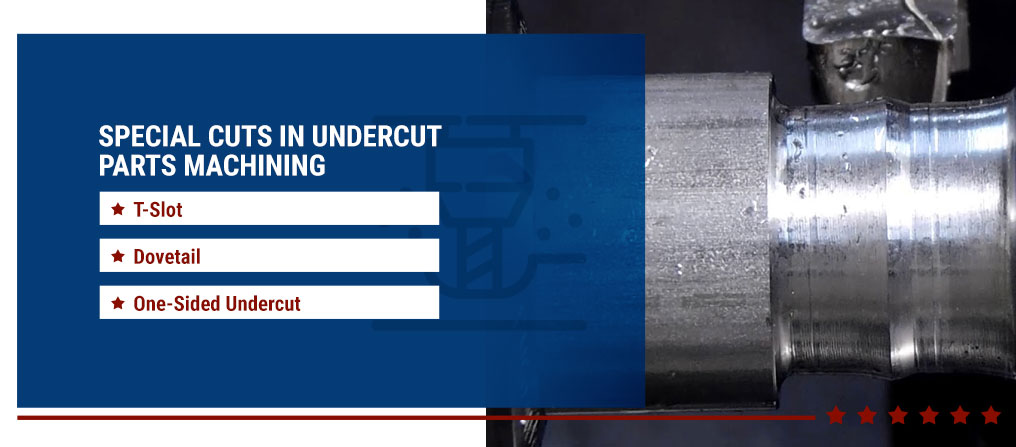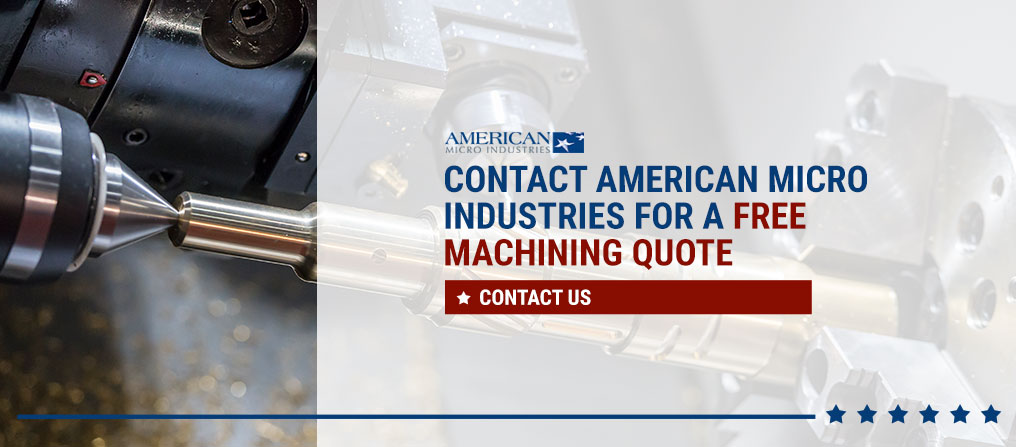Jump to:
- What Is an Undercut Machining?
- Special Tools for Undercut Machining
- Special Cuts in Undercut Parts Machining
- Tips for Parts With Undercuts
- Contact American Micro Industries for a Free Machining Quote
When you’re machining a part, some designs are easier to produce than others, so the machinability of different features is an essential consideration to keep in mind. Where larger features and shallow cavities are relatively easy to machine, trickier features like undercuts present a challenge. Fortunately, you can use specialized tools and design modifications to make the job a little easier.
What Is an Undercut Machining?
Undercuts are recessed features that standard cutting tools like end mills cannot create. They require the use of specialized tools because some of their surfaces are not directly accessible from overhead. Designing parts with undercuts can be challenging — these products are more difficult to manufacture and generally incur steeper costs, and specific machining undercut standards can be hard to attain.
Many undercuts occur where one part of the workpiece overhangs another part. The overhang creates a gap that traditional tools like routers and three-axis mills cannot reach.
For example, imagine a plate with a hook extending outward from it, as on a metal coat rack laid on its back. The space under the hook and above the plate is impossible to machine with standard tools. It requires the use of specialized cutters and techniques — otherwise, you would have to machine the two parts separately and then glue or bolt them together.
Learn About Our CNC Machining Services
Special Tools for Undercut Machining
Simple undercuts often require tools known as slot cutters and lollipop cutters, the latter also known as undercutting end mills. These tools have distinctive shapes that allow them to craft undercuts where traditional machining tools cannot.
Slot Cutters and Lollipop Cutters
Both slot cutters and lollipop cutters feature a narrow shaft with a wider tip at the end. In slot cutters, the tip is flatter, and in lollipop cutters, the tip is round, ideal for cutting curved shapes. The distance between the outside of the tip and the edge of the shaft is the distance the machinist can cut under the overhanging surface. Lollipop cutters in particular are also useful for deburring and edge-breaking any part of the workpiece, including the underside.
Lollipop cutters are available in a variety of wrap angles, such as 220 degrees and 300 degrees. Cutters with thinner necks achieve larger wrap angles and create a more spherical cutting end, offering greater clearance. Cutters with thicker necks have smaller wrap angles, so they provide less clearance but more rigidity and stability.
Slot cutters and lollipop cutters can be handy tools, especially for simple undercuts. One disadvantage they have, though, is that most computer-aided manufacturing (CAM) software does not contain the algorithms required to support them. It is possible to use these tools with CAM software, but doing so typically requires a clunky workaround such as using manual G-code or manipulating the mill manually.
Special Cuts in Undercut Parts Machining
Below are a few unique cuts you may perform when a product requires an undercut. The two main types of undercuts are t-slots and dovetails, and one-sided undercuts are sometimes necessary as well.
Learn About Our CNC Machining Services
T-Slot
A t-slot cutting tool consists of a vertical shaft with an attached flat horizontal blade. This device can cut down into the workpiece and also cut horizontally in either direction, creating a T-shaped undercut. T-slot tools of different standard widths are available to create undercuts ranging in size from about 3 millimeters to 40 millimeters.
Dovetail
A dovetail tool uses an angled blade to create undercuts. The resulting cuts have a fanned or dovetail shape — a trapezoid narrower at the top and broader at the bottom.
Dovetail cutting tools are available in standard angles of 45 and 60 degrees — other angles are possible, usually angles in multiples of 10 degrees, up to 120 degrees, though these are less common.
One-Sided Undercut
A one-sided undercut differs from T-slot and dovetail cuts in that while the former create symmetrical shapes, a one-sided undercut does not. A one-sided undercut uses a special tool to cut sideways and make an additional cut that protrudes from the original undercut, much like the protrusion on a standard puzzle piece.
If you’re designing an internal wall with a one-sided undercut, keeping clearance in mind is essential. Leaving a primary width of four times the undercut depth will help ensure the tool has enough clearance to work properly.
Learn About Our CNC Machining Services
Tips for Parts With Undercuts
Below are a few essential tips for handling undercuts in your machining operations:
1. Eliminate Undercuts If Possible
If you can, avoid undercuts in your designs altogether. Because they are cumbersome to work with and require specialized tools and crafting, it’s often more efficient and cost-effective to leave them out. In some cases, you can design a workpiece — usually by including a space for the tool — where you use standard machining from the back on what would otherwise be a tricky undercut from the front. In others, you may be able to create designs where undercuts are unnecessary.
2. Make Shallow Cuts
When you use tools to make undercuts, try to perform shallow cuts — the shallower the better. Because the blades of many undercutting tools are attached to vertical shafts, the depths to which they can reach are limited. When you’re designing an undercut feature, it’s essential to create undercuts only at depths that the available tools can handle.
3. Avoid the Need for a Custom Tool
Custom tools are expensive and take time to manufacture, so you should try to minimize the need for these tools if you can. Fortunately, you can often avoid the need for costly, one-time-use custom tools by designing your undercut features with standard dimensions. If you need to make a dovetail cut at a 15-degree angle, for instance, finding a tool to do so will be exceptionally difficult. A standard 45-degree cut will make the machining process more manageable.
Learn About Our CNC Machining Services
4. Partner With Professionals
In some cases, creating the product you need becomes much easier if you partner with a professional machining company for the work. A professional company has the experience, expertise and tools available to handle even the trickiest shapes. If you’re unsure about an undercut layout or the execution of the cut, getting assistance with the work can help optimize the design, ensure the highest undercut machining standards and reduce the risk of errors.
Contact American Micro Industries for a Free Machining Quote
To see the benefits of quality custom machining for your products, contact American Micro Industries. Our full-service in-house shop offers CNC machining, plastic machining, die cutting, laser cutting and various other custom options. We also have extensive experience in prototype machining for an array of industries, including the aerospace, automotive, defense, medical and technology industries.
Request your free quote today, or contact us to learn more.




